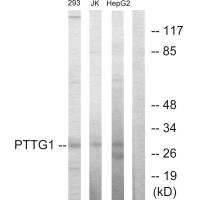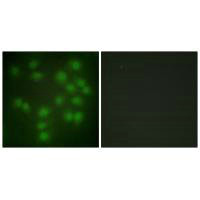
Western blot analysis of extracts from 293 cells, Jurkat cells and HepG2 cells, using PTTG1 antibody.
PTTG1 Antibody

CSB-PA443065
ApplicationsImmunoFluorescence, Western Blot, ELISA
Product group Antibodies
ReactivityHuman
TargetPTTG1
Overview
- SupplierCusabio
- Product NamePTTG1 Antibody
- Delivery Days Customer20
- ApplicationsImmunoFluorescence, Western Blot, ELISA
- CertificationResearch Use Only
- ClonalityPolyclonal
- ConjugateUnconjugated
- Gene ID9232
- Target namePTTG1
- Target descriptionPTTG1 regulator of sister chromatid separation, securin
- Target synonymsEAP1; ESP1-associated protein 1; HPTTG; pituitary tumor-transforming 1; pituitary tumor-transforming gene 1 protein; PTTG; securin; tumor-transforming protein 1; TUTR1
- HostRabbit
- IsotypeIgG
- Protein IDO95997
- Protein NameSecurin
- Scientific DescriptionRegulatory protein, which plays a central role in chromosome stability, in the p53/TP53 pathway, and DNA repair. Probably acts by blocking the action of key proteins. During the mitosis, it blocks Separase/ESPL1 function, preventing the proteolysis of the cohesin complex and the subsequent segregation of the chromosomes. At the onset of anaphase, it is ubiquitinated, conducting to its destruction and to the liberation of ESPL1. Its function is however not limited to a blocking activity, since it is required to activate ESPL1. Negatively regulates the transcriptional activity and related apoptosis activity of TP53. The negative regulation of TP53 may explain the strong transforming capability of the protein when it is overexpressed. May also play a role in DNA repair via its interaction with Ku, possibly by connecting DNA damage-response pathways with sister chromatid separation. Dominguez A., Oncogene 17:2187-2193(1998). Kakar S.S., Cytogenet. Cell Genet. 84:211-216(1999). Zhang X., Mol. Endocrinol. 13:156-166(1999).
- ReactivityHuman
- Storage Instruction-20°C or -80°C
- UNSPSC12352203

